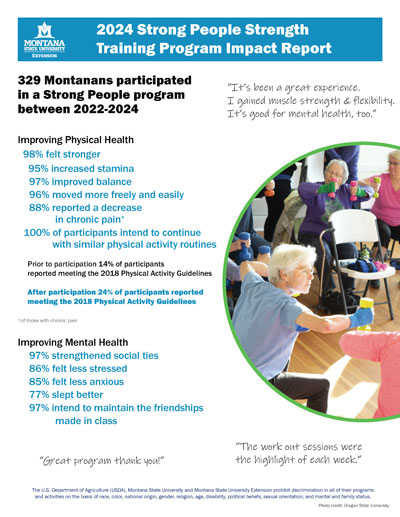Strong People Impact Report
View, download and/or print the 2024 Strong People Strength Training Program Impact Report here.
2024 STRONG PEOPLE® STRENGTH TRAINING PROGRAM IMPACT REPORT
Strong People® is an evidence-based, 12-week program provided by MSU Extension that helps participants increase their joint flexibility, muscle strength, balance, and overall well-being. 329 Montanans participated in a Strong People program between 2022-2024.
Improving Physical Health
- 98% felt stronger
- 95% increased stamina
- 97% improved balance
- 96% moved more freely and easily
- 88% reported a decrease in chronic pain*
- 100% of participants intend to continue with similar physical activity routines
- Prior to participation 14% of participants reported meeting the 2018 Physical Activity Guidelines
- After participation 24% of participants reported meeting the 2018 Physical Activity Guidelines
*of those with chronic pain
Improving Mental Health
- 97% strengthened social ties
- 86% felt less stressed
- 85% felt less anxious
- 77% slept better
- 97% intend to maintain the friendships made in class
PHYSICAL ACTIVITY GUIDELINES FOR AMERICANS
Key Guidelines for Adults
- Adults should move more and sit less throughout the day. Some physical activity is better than none.
- Adults who sit less and do any amount of moderate-to-vigorous physical activity gain some health benefts.
- For substantial health benefts, adults should do at least 150 minutes (2 hours and 30 minutes) to 300 minutes (5 hours) a week of moderate-intensity, or 75 minutes (1 hour and 15 minutes) to 150 minutes (2 hours and 30 minutes) a week of vigorous-intensity aerobic physical activity, or an equivalent combination of moderate- and vigorous-intensity aerobic activity. Preferably, aerobic activity should be spread throughout the week.
- Additional health benefts are gained by engaging in physical activity beyond the equivalent of 300 minutes (5 hours) of moderate-intensity physical activity a week.
- Adults should also do muscle-strengthening activities of moderate or greater intensity and that involve all major muscle groups on 2 or more days a week, as these activities provide additional health benefts.
Quotes from participants:
“It’s been a great experience. I gained muscle strength & flexibility. It’s good for mental health, too.”
“Great program thank you!”
“The work out sessions were the highlight of each week.”
Key Guidelines for Older Adults
The key guidelines for adults also apply to older adults. In addition, the following key guidelines are specifically for older adults:
- As part of their weekly physical activity, older adults should do multicomponent physical activity that includes balance training as well as aerobic and muscle-strengthening activities.
- Older adults should determine their level of effort for physical activity relative to their level of ftness.
- Older adults with chronic conditions should understand whether and how their conditions affect their ability to do regular physical activity safely.
- When older adults cannot do 150 minutes of moderate-intensity aerobic activity a week because of chronic conditions, they should be as physically active as their abilities and conditions allow.
Key Guidelines for Adults With Chronic Health Conditions and Adults With Disabilities
- Adults with chronic conditions or disabilities, who are able, should do at least 150 minutes (2 hours and 30 minutes) to 300 minutes (5 hours) a week of moderate-intensity, or 75 minutes (1 hour and 15 minutes) to 150 minutes (2 hours and 30 minutes) a week of vigorous-intensity aerobic physical activity, or an equivalent combination of moderate- and vigorous-intensity aerobic activity. Preferably, aerobic activity should be spread throughout the week.
- Adults with chronic conditions or disabilities, who are able, should also do muscle-strengthening activities of moderate or greater intensity and that involve all major muscle groups on 2 or more days a week, as these activities provide additional health benefts.
- When adults with chronic conditions or disabilities are not able to meet the above key guidelines, they should engage in regular physical activity according to their abilities and should avoid inactivity.

